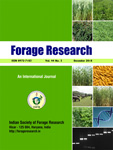SATPAL*, B. GANGAIAH, S. DEVI, N. KHAROR, P. KUMARI AND B. L. SHARMA
Department of Genetics & Plant Breeding (Forage Section), 3Department of Botany & Plant Physiology
CCS Haryana Agricultural University, Hisar-125 004 (Haryana), India
ICAR – Indian Institute of Millets Research, Hyderabad-500 030 (Telangana), India
*(e-mail: satpal.fpj@gmail.com)
(Received: 8 March 2025; Accepted: 30 March 2025)
SUMMARY
A field experiment was conducted to assess the impact four graded levels of recommended dose of fertilizers (RDF 0, 50, 100 and 150% with 80.0-17.5-33.2 kg N-P-K/ha as RDF) on fodder
productivity, quality and economics of ten single cut forage sorghum [Sorghum bicolor (L.) Moench] genotypes (4 single cut non-BMR forage genotypes i.e. SPV 2885, SPV 2998, SPV 2983, SPV 2985 with CSV 43 & CSV 35F as checks and 3 brown mid rib (BMR) genotypes i.e. SPV 2912 BMR, SPV 2814BMR, SPV 2997BMR with CSV 43BMR as check) at Hisar (Haryana), India during kharif season of 2024 using Split plot design with two replications. Results revealed that non-BMR genotype ‘SPV 2983’ with. 43.40 and 10.67 t/ha of green and dry fodder yields has excelled both the checks CSV 35F and CSV 43 by 80 & 84 and 136 & 149 per cent, respectively and was promising from crude protein and net income point of view also. Among BMR genotypes, SPV 2814BMR with 21.13 and 4.88 t/ha of green and dry fodder yields has excelled its check CSV 43BMR by 24.73 and 24.81%, respectively. Higher fodder yields of SPV 2983 and SPV 2814BMR over their respective checks was due to their tall plants. HCN content was the least in SPV 2912BMR (48.7 µg/g) and the highest (89.8 µg/g) in SPV
2998. Highest fodder producing genotype (SPV 2983) was more depletive of soil nutrients. Among RDF levels, significant improvement was seen in leaf area index values only with 150% RDF application over RDF and thus RDF was best for realizing the not only the fodder yield but also returns. Fertilizers (RDF) have contributed to 67.8, 65.4 and 165.7% green, dry fodder yield and net income enhancements at the test site as compared to 0% RDF i.e. unfertilized control (14.83, 3.53 t/ha and ¹-9936). Inherent soil fertility (0% RDF) has contributed to 45.3-3.8-37.8 kg/ha N-P-K uptake of forage sorghum crop producing highest dry fodder/kg NPK uptake (78.7-841.7-93.5 kg fodder / kg N-P-K) and uptake increased 2.12-3.26-1.93 times with RDF use. HCN content increased from 53.6 to 76.2 µg/g as RDF increased from 0 to 150% RDF. It is concluded that single cut non-BMR forage sorghum genotype ‘SPV 2983’ is promising while among BMR genotypes, SPV 2914BMR is promising and is at par with all non-BMR genotypes except CSV 35F and SPV 2983. High digestibility of BMR genotypes
(7-9%) may make them as good as CSV-35F. Application of 100% RDF (80.0-17.5-33.2 kg/ha N-P-K) was recommended for higher fodder yield, quality and income.
Key words: Sorghum, single-cut, forage, brown mid rib (BMR), genotypes, fertilizer levels, fodder yield, HCN and crude protein
474-482

